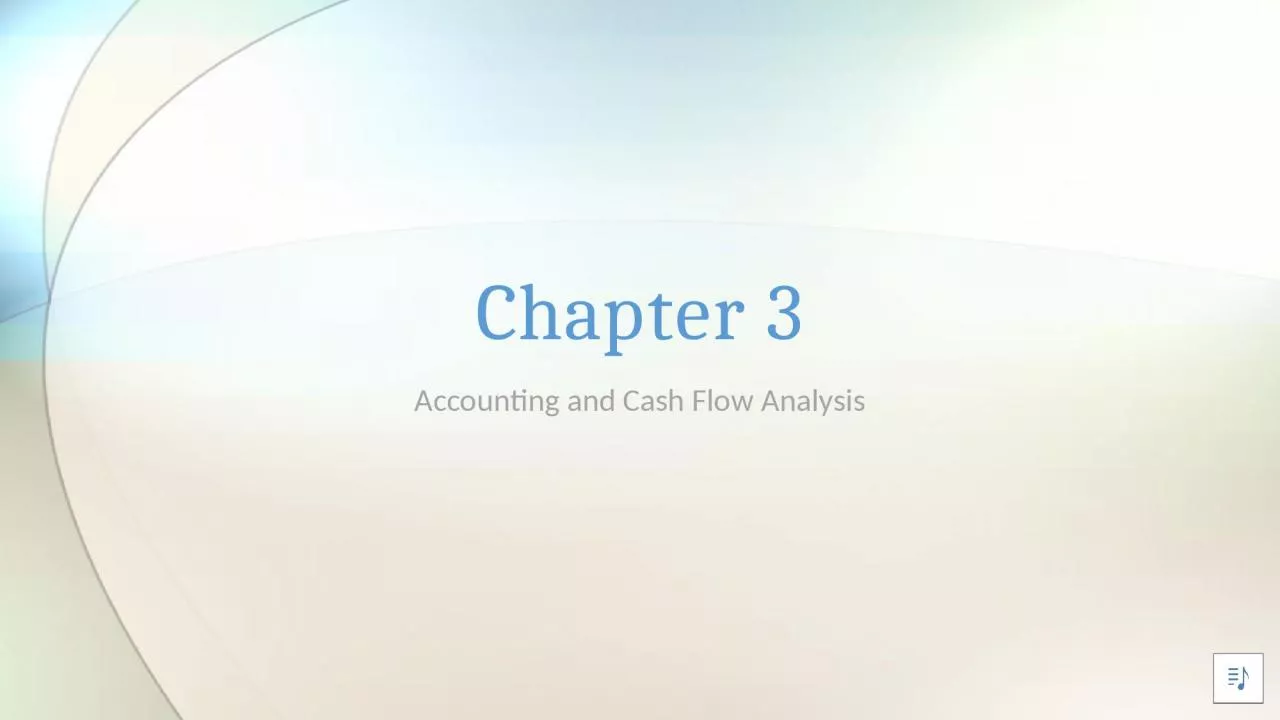

Financial managers need to analyze the accounting records to Understand how things have worked in the past Effects of a course of action Costs and benefits of an action Why do we need to study accounting ID: 1044506
Download Presentation The PPT/PDF document "Chapter 3 Accounting and Cash Flow Analy..." is the property of its rightful owner. Permission is granted to download and print the materials on this web site for personal, non-commercial use only, and to display it on your personal computer provided you do not modify the materials and that you retain all copyright notices contained in the materials. By downloading content from our website, you accept the terms of this agreement.
1. Chapter 3Accounting and Cash Flow Analysis
2. Financial managers need to analyze the accounting records to…Understand how things have worked in the pastEffects of a course of actionCosts and benefits of an action Why do we need to study accounting?
3. Financial accountant = designs procedures for the recording of transactions, supervises that record-keeping function, and is responsible for summarizing records in financial statementsManagerial accountant = take information about the costs of doing business from the financial records. Once information is gathered, they analyze it to find out how costs change with changing volume and how well management is doing at controlling costsAuditors = responsible for verifying that financial statements are prepared with GAAPInternal auditor = ensure that adequate records are maintained to support the financial statements that the organization presentsFields of accounting practice
4. HFMACHFPFHFMAProfessional organizations
5. Basic accounting equation = Assets = liabilities + owner’s equity Assets = all things (tangible and intangible) that are ownedTangible IntangibleCurrent assets Liabilities = all items that the entity owes to otherAccounts payable Interest payable Long-term debt Current liabilitiesOwner’s equity = difference between the value of the entity’s assets and its liabilities. It is what could be claimed were owned that could be liquidatedAccounting Principles
6. Two sides are typically called Debits (left) = credit (right) Debits & Credits
7. Monetary terms = all items must be written in terms of money Example: What vehicles are in possessionMonetary terms
8. Vehicle WRONGOne 15 –year old ambulanceCORRECT$35,000VEHICLES IN POSSESSION
9. Example: Patient A receives surgery for a compound fracture in June but hospital gets paid for services in August. The organization receives $50,000 Surgery for compound fracture for Patient A = WrongEXAMPLE ProcedureCost of servicesJuneCompound fracture0July 0August 50,000 ProcedureCost of servicesJuneCompound fracture50,000July-0 August 0
10. ASSETS = LIABILITIES (EQUITY) ASSETS GOES UP = DEBITSASSETS GOES DOWN = CREDITLIABILITY/EQUITY GOES UP = CREDITLIABILITIES/EQUITY GOES DOWN = DEBITSREVENUES = ARE ALWAYS CREDIT EXPENSES = ARE ALWAYS DEBITS Basic accounting entries = double-entry = each transaction will go on to different ledgers (debits and credits) RULES FOR CREDITS AND DEBITS
11. Investor provided 100K in cash to start HHSC TABLE 3-1: Initial contribution of capital DateTransactiondr (debits)cr (credits)1/1/2013Cash Paid-in capital$100,000.00 $100,000.00
12. Contract for home health visits - $50/visit = paid only at the end of the quarterJanuary – February – March (1st quarter)January = 1st month of quarter, no money until quarter ends = early April 120 visits AR = money owed for services rendered, but not yet paidTABLE 3-2: First revenues receivedDateTransactiondr (debits)cr (credits)1/31/2013Accounts receivable Revenue$6,000.00 $6,000.00
13. Three nurses make home health visits and are paid as contracts at a rate of $35/visitEnd of January, they have to be paid a total of $4,200TABLE 3-3: Nursing service expense incurredDateTransactiondr (debits)cr (credits)1/31/2013Nursing service expense Cash$4,200.00 $4,200.00
14. Purchase a personal computer system to use in managing the accountsCost to purchase and install the system was $6,000Table 3-4: Purchase of computing equipment for cash DateTransactiondr (debits)cr (credits)1/15/2013Computing equipment Cash$6,000 $6,000